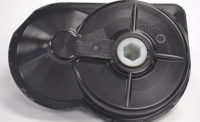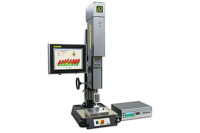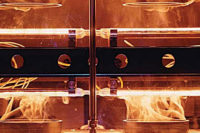In 1998, the odelo Group developed and began production of the world’s first full-LED rear light for automobiles. Although noteworthy, this achievement is but one of many for the company, which has manufactured rear and tail lights for all German premium-vehicle OEMs since 1935.
More recently, odelo developed a new rear light for the Mercedes-Benz T-model (an E-Class size vehicle), and received a 2016 GKV/TechPart Innovation Award for this work. The light features mirrored surfaces and functions that are hybrid laser welded to the edge of the light housing.
Separately, odelo designers have spent the past few years looking for ways to improve rear and tail light aesthetics. This research stems from OEMs increasingly wanting lights to be a design element on a vehicle, rather than just a functional necessity. Not surprisingly, it has required odelo to find new ways to join rear and tail lights to moldings.
Traditional joining methods often cause particle buildup, resulting in panes that are less transparent and visible to following vehicles. Neither characteristic is acceptable to
odelo’s customers, which include Audi, BMW, Ferrari, Mercedes Benz, Rolls Royce, Maserati, Saab, VW and Volvo.
These companies require lights that are clearly visible, particle free and uniformly welded, even when they feature complex contours (such as 3D moldings or level changes in the joining plane), and sensitive LEDs and electronic components. In addition, the OEMs have tight tolerances for temperature-resistant plastics and light transfer from multipart lights.
Odelo relies on Branson Ultrasonics Corp.’s GVX-2HR vibration welder with dual-axis Clean Vibration Technology (CVT) to meet all of these challenges. CVT uses infrared power emitters that preheat part joints and allow the vibration weld to be delayed until the viscous phase. This process prevents the creation of particles and melting filaments, resulting in fast, consistent, clean, particulate-free and energy-efficient welds. CVT also offers programmable motion control and fast tool travel to rapidly weld parts with complex 2D and 3D geometries.
The welder’s large lift table (1,070 by 600 millimeters) is driven by a precise servomotor at rates up to 500 meters per second. Its lower fixture provides up to 25 kilonewtons of clamp force with accurate, closed-loop calibration and control.
Two other key features are the vibration head (880 by 376 millimeters) that welds small and large parts, and an interface that accommodates up to 99 different users with configurable access rights. The interface offers a digital display, intuitive navigation with easily
recognized icons, and a sequence editor for simple production programming. Operators can select from dozens of tooling codes and welding specifications, access production-related functions and prevent modifications of critical welding parameters.
A durable enclosure keeps the welder quiet (77 decibels maximum) during operation. Short-cycle or automated part loading and unloading is done at the welder’s front door, and tool changes are made at the rear. A quick-tooling-change feature provides auto-connectivity between fixture components (pneumatic or electric) and table spring balls. LED lighting improves workplace visibility. There are no cam plates or cylinders, further increasing speed.
For more information on vibration welders, call 203-796-0400 or visit www.bransonultrasonics.com.





